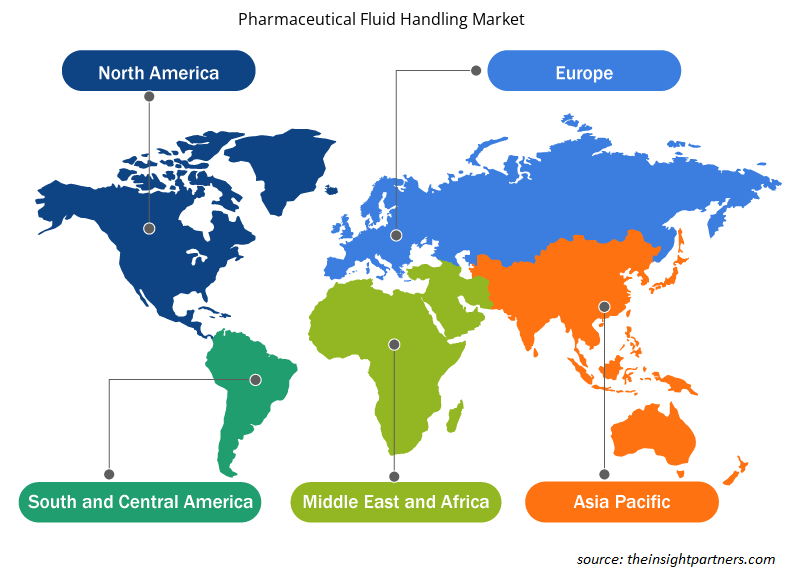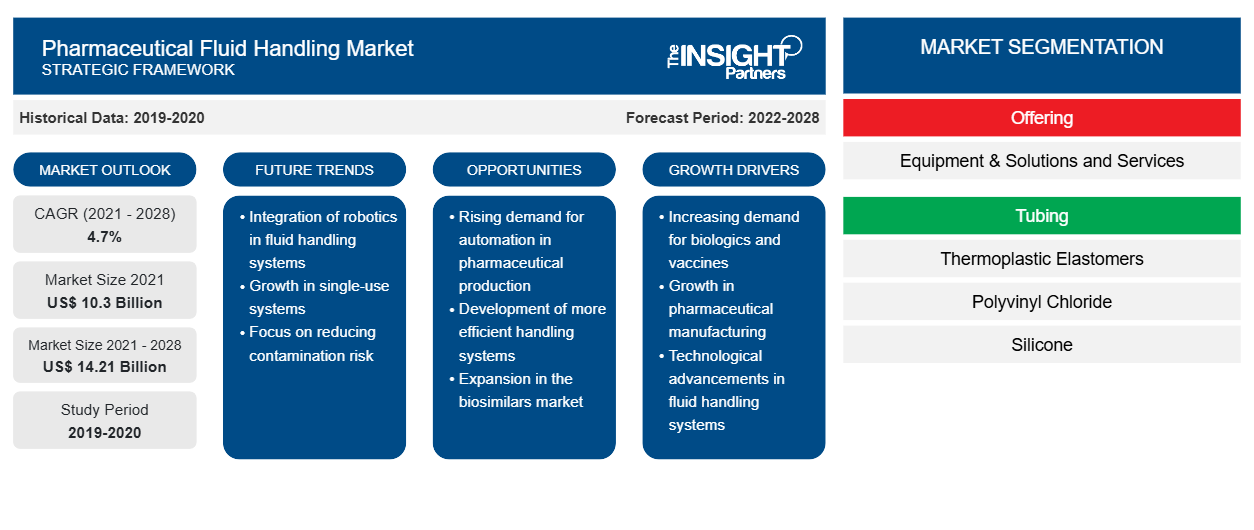预计到 2028 年,制药流体处理市场规模将从 2021 年的 103.0278 亿美元增至 142.094 亿美元;预计 2022 年至 2028 年的复合年增长率为 4.7%。CAGR of 4.7% from 2022 to 2028.
制药流体处理是制药行业不可或缺的一部分,旨在确保止咳糖浆、静脉注射产品和复杂活性药物成分等流体能够安全及时地输送。为了取得成功和获得可靠性,企业需要使用正确的处理设备和仪器。生物技术和制药行业的制造部门需要流体控制系统,因为它们的大多数工艺都涉及液体,例如进料培养基、缓冲溶液、细胞提取物和产品馏分。
医药流体处理市场根据产品、管道、应用、用途、最终用户和地理位置进行细分。按地理位置划分,市场大致分为北美、欧洲、亚太地区、中东和非洲以及南美和中美洲。该报告提供了对市场的见解和深入分析,重点关注市场趋势、技术进步和市场动态等参数,以及对世界主要市场参与者的竞争格局的分析。
定制此报告以满足您的需求
您可以免费定制任何报告,包括本报告的部分内容、国家级分析、Excel 数据包,以及为初创企业和大学提供优惠和折扣
- 获取此报告的关键市场趋势。这个免费样品将包括数据分析,从市场趋势到估计和预测。
市场洞察
制药行业一次性系统 (SUS) 的采用率上升
在制药和生物制药产品制造中,污染预防是该过程的关键部分。正确处理和储存液体对于限制污染的可能性至关重要。设施布局有助于确定公司处理液体转移和储存的方法。一次性系统 (SUS) 的日益普及减少了产品交叉污染,消除了批次之间清洁的需要,从而提高了效率。SUS 在洁净室中制造;它们是双层包装的,并使用伽马射线、环氧乙烷或 x 射线方法确保每批产品都采用无菌系统。
在疫苗、单克隆抗体和个性化药物等多种药品的开发过程中,SUS 被使用,因为它提供了更快、更简单、更便宜的制造工艺。由于慢性病患病率不断上升,对有效药物和产品的需求不断增长。因此,越来越多的公司选择 SUS,因为它可以提高流程效率并降低与清洁、灭菌和维护相关的成本。此外,低污染风险和低水消耗是支持制药流体处理市场增长的一些因素。市场增长还归因于公司活动的增加以及各种业务战略的快速采用,例如合作、伙伴关系和产品发布。例如,2022 年 4 月,默克与无锡国家高新技术产业开发区签署协议,扩建其首个亚太地区 Mobius 一次性制造中心。
因此,SUS 在无菌液体生产和转移中的使用增加正在推动制药液体处理市场的增长。
疫苗产量增加
疫苗可增强不同年龄组的免疫系统,预防传染病。在过去的几十年里,有效的免疫接种已经消灭了死亡率很高的脊髓灰质炎和天花。近年来,由于病毒和细菌性传染病发病率上升,疫苗接种需求有所增加。此外,政府基金会、医院和制药公司正致力于通过在全球范围内提供具有成本效益的免疫接种来定期接种疫苗。这推动了对疫苗生产的需求,这可能会促进制药液体处理市场的增长。例如,印度全民免疫计划 (UPI) 向 210 万名儿童推广了肺炎球菌结合疫苗。此外,政府资助和公司投资正在刺激研发推出新产品。根据世界卫生组织的数据,截至 2022 年 11 月,2021 年共供应了 160 亿剂疫苗,价值 1410 亿美元,约为 2019 年供应剂量(58 亿剂)的三倍。由于专注于开发 COVID-19 疫苗,印度血清研究所 (SII) 将HPV 疫苗生产推迟了两年;但是,它将在 2023 年开始向印度政府少量供应 HPV 疫苗。因此,预计疫苗产量的增加将在预测期内为制药液体处理市场创造机会。
基于管道的见解
根据管道,全球制药流体处理市场细分为热塑性弹性体 (TPE)、聚氯乙烯 (PVC) 和硅胶。2022 年,硅胶部分占据了最大的市场份额。TPE 部分预计将在 2022-2028 年期间以最高的复合年增长率增长。热塑性弹性体 (TPE) 具有出色的加工性能,使其适用于所有传统挤出工厂和注塑成型。它们具有成本效益,排放量更低,可重复使用性可靠。高质量的专用管道对于设计高效的制药流体处理系统至关重要;预灭菌管道需要满足特定的制造标准,并且当管道暴露于高压灭菌、气体处理、伽马射线辐照和其他灭菌方法时,灭菌能力是必需的。生物制药管道的一个重要考虑因素是其焊接和密封能力;TPE 可以焊接和热封。例如,2022年5月18日,医疗和制药设备制造商科德宝医疗推出了HelixFlex,它结合了所有优点,即可焊接、半透明、可密封,可用于蠕动泵应用。高纯度热塑性弹性体TPE管专为生物制药和制药应用而设计。
基于应用的洞察
根据应用,制药流体处理市场细分为流体处理和管理、流体制备、集成和自动化、无菌处理、缓冲液管理等。流体处理和管理部门在 2021 年占据了最大的市场份额;然而,到 2028 年,集成和自动化部门预计将进一步成为市场的最大股东。自动化是不可避免的,而且不断扩大。随着技术的不断进步,自动化显示出改变流程和引入性能改进的潜力。在制药行业,自动化的使用还通过其持续执行重复任务的能力减少了人为错误的可能性。制药公司一直在将自动化整合到药物开发、序列化和防伪等特定过程中。在制造示例中,自动化已在流体处理和管理等过程中变得普遍。自动化对于体外诊断 (IVD)、分子分析、流式细胞术、下一代测序 (NGS) 或细胞生物学系统至关重要。此外,将混合技术与过滤和流体管理相结合,可以使用标准配方自动制备流体以混合、调节 pH 值和过滤工艺缓冲液。因此,预计未来几年对自动机的需求不断增长将推动制药流体处理市场的发展。
产品发布和并购是全球制药流体处理市场参与者广泛采用的策略。以下列出了一些近期的关键产品开发:
- 2022 年 10 月,领先的科技公司默克在法国马蒂拉克的公司基地为其新的 Millipore CTDMO 服务产品开设了一个商业设施。
- 2022 年 7 月,总部位于爱沙尼亚首都塔林的 A&G AS 自 2021 年起成为 Raumedic 集团公司的一部分。该公司专门从事医疗技术领域的组装,并配备了相应的洁净室生产空间。
COVID-19 疫情扰乱了全球人民和企业的日常生活,医药供应链也受到了极大影响。COVID-19 疫情给医疗保健基础设施带来了巨大压力,阻碍了生物制药公司和临床实验室的运营能力。COVID-19 疫情导致行业增长显著,因为对 COVID-19 病毒的研究需要在实验室中更快地处理样本,因此对医药液体处理的需求很高。COVID-19 疫苗的开发推动了对先进自动化液体处理系统的需求。由于 COVID-19 疫情的爆发,市场出现了积极增长。
制药流体处理市场区域洞察
Insight Partners 的分析师已详尽解释了预测期内影响制药流体处理市场的区域趋势和因素。本节还讨论了北美、欧洲、亚太地区、中东和非洲以及南美和中美洲的制药流体处理市场细分和地理位置。

- 获取制药流体处理市场的区域特定数据
制药流体处理市场报告范围
| 报告属性 | 细节 |
|---|---|
| 2021 年市场规模 | 103亿美元 |
| 2028 年市场规模 | 142.1亿美元 |
| 全球复合年增长率(2021 - 2028) | 4.7% |
| 史料 | 2019-2020 |
| 预测期 | 2022-2028 |
| 涵盖的领域 | 通过奉献
|
| 覆盖地区和国家 | 北美
|
| 市场领导者和主要公司简介 |
|
制药流体处理市场参与者密度:了解其对业务动态的影响
制药流体处理市场正在快速增长,这得益于最终用户需求的不断增长,而这些需求又源于消费者偏好的不断变化、技术进步以及对产品优势的认识不断提高等因素。随着需求的增加,企业正在扩大其产品范围,进行创新以满足消费者的需求,并利用新兴趋势,从而进一步推动市场增长。
市场参与者密度是指在特定市场或行业内运营的企业或公司的分布情况。它表明在给定市场空间中,相对于其规模或总市场价值,有多少竞争对手(市场参与者)存在。
在制药流体处理市场运营的主要公司有:
- CIRCOR 国际公司
- 派克汉尼汾公司
- 丹纳赫公司
- 斯派莎克工程公司
- 默克公司
免责声明:上面列出的公司没有按照任何特定顺序排列。

- 了解制药流体处理市场的主要参与者概况
制药流体处理 – 市场细分
根据产品,市场细分为设备与解决方案和服务。设备与解决方案进一步细分为计量泵和胶囊设备(灌装/分类)、混合设备和阀门、热处理设备(冷却器/冷冻机/干燥机/热交换器)、X 射线检测系统、液体储罐和流量控制产品、过滤器/过滤器组(预过滤器/除菌级过滤器/病毒过滤器)、粉末处理袋、无菌连接器/断开器和膜滤芯等。根据管道,市场细分为 TPE、PVC 和硅胶。根据应用,市场细分为流体处理和管理、流体制备、集成和自动化、无菌处理、缓冲液管理等。流体处理和管理部分进一步细分为一次性系统和多用途系统、生物处理工作站、标准存储系统和生物容器、手提箱等。根据用途,市场细分为止咳糖浆、静脉注射产品、复杂 API 和其他。复杂 API 部分进一步分为疫苗、癌症治疗药物和其他。根据最终用户,市场细分为生物技术公司、制药和医疗公司和其他。根据地理位置,市场分为北美(美国、加拿大和墨西哥)、欧洲(法国、德国、英国、意大利、西班牙和欧洲其他地区)、亚太地区(中国、日本、印度、澳大利亚、韩国和亚太其他地区)、中东和非洲(沙特阿拉伯、南非、阿联酋和中东和非洲其他地区)、南美洲和中美洲(巴西、阿根廷和南美洲和中美洲其他地区)。
公司简介
- CIRCOR国际公司
- 派克汉尼汾公司
- 丹纳赫公司
- 斯派莎克工程公司
- 默克公司
- 罗奇林两合公司
- 瑞士劳美迪克公司
- Tef Cap 工业公司
- 弗雷泽罗斯有限公司
- 澳大利亚流体处理有限公司
- 历史分析(2 年)、基准年、预测(7 年)及复合年增长率
- PEST 和 SWOT 分析
- 市场规模价值/数量 - 全球、区域、国家
- 行业和竞争格局
- Excel 数据集



Report Coverage
Revenue forecast, Company Analysis, Industry landscape, Growth factors, and Trends

Segment Covered
This text is related
to segments covered.

Regional Scope
North America, Europe, Asia Pacific, Middle East & Africa, South & Central America

Country Scope
This text is related
to country scope.
常见问题
The biotechnology companies segment dominated the pharmaceutical fluid handling market and accounted for the largest market share in 2021.
CIRCOR Internatioonal Inc., Parker Hannifin Corp, Danaher Corp, Spirax Sarco Engineering plc, Merck KGaA, Rochling SE & Co KG, RAUMEDIC AG, Tef Cap Industries Inc, Fraser Ross Ltd, Australian Fluid Handling Pty Ltd among others are among the leading companies operating in the pharmaceutical fluid handling market.
Based on the usage, cough syrup segment took the forefront leaders in the worldwide market by accounting largest share in 2021 and is expected to continue to do so till the forecast period.
Based on offering segment, the equipment segment took the forefront leaders in the worldwide market by accounting largest share in 2021 and is expected to continue to do so till the forecast period.
Surge in drug production and rise in adoption of single-use systems (SUS) in pharmaceutical industry are the most significant factors responsible for the overall market growth.
Pharmaceutical fluid handling is an integral part of pharmaceutical industry to ensure that fluids such as cough syrups, intravenous products, and complex active pharmaceutical ingredients are delivered in a safe and timely manner. To succeed and be reliable, businesses need to utilize the correct handling equipment and instruments. The manufacturing divisions in the biotechnology and pharmaceutical industry require fluid control systems since their most processes involve liquid such as feed media, buffer solutions, cell extracts, and product fractions.
Trends and growth analysis reports related to Life Sciences : READ MORE..
The List of Companies - Pharmaceutical Fluid Handling Market
- CIRCOR Internatioonal Inc
- Parker Hannifin Corp
- Danaher Corp
- Spirax Sarco Engineering plc
- Merck KGaA
- Rochling SE & Co KG
- RAUMEDIC AG
- Tef Cap Industries Inc
- Fraser Ross Ltd
- Australian Fluid Handling Pty Ltd
The Insight Partners performs research in 4 major stages: Data Collection & Secondary Research, Primary Research, Data Analysis and Data Triangulation & Final Review.
- Data Collection and Secondary Research:
As a market research and consulting firm operating from a decade, we have published and advised several client across the globe. First step for any study will start with an assessment of currently available data and insights from existing reports. Further, historical and current market information is collected from Investor Presentations, Annual Reports, SEC Filings, etc., and other information related to company’s performance and market positioning are gathered from Paid Databases (Factiva, Hoovers, and Reuters) and various other publications available in public domain.
Several associations trade associates, technical forums, institutes, societies and organization are accessed to gain technical as well as market related insights through their publications such as research papers, blogs and press releases related to the studies are referred to get cues about the market. Further, white papers, journals, magazines, and other news articles published in last 3 years are scrutinized and analyzed to understand the current market trends.
- Primary Research:
The primarily interview analysis comprise of data obtained from industry participants interview and answers to survey questions gathered by in-house primary team.
For primary research, interviews are conducted with industry experts/CEOs/Marketing Managers/VPs/Subject Matter Experts from both demand and supply side to get a 360-degree view of the market. The primary team conducts several interviews based on the complexity of the markets to understand the various market trends and dynamics which makes research more credible and precise.
A typical research interview fulfils the following functions:
- Provides first-hand information on the market size, market trends, growth trends, competitive landscape, and outlook
- Validates and strengthens in-house secondary research findings
- Develops the analysis team’s expertise and market understanding
Primary research involves email interactions and telephone interviews for each market, category, segment, and sub-segment across geographies. The participants who typically take part in such a process include, but are not limited to:
- Industry participants: VPs, business development managers, market intelligence managers and national sales managers
- Outside experts: Valuation experts, research analysts and key opinion leaders specializing in the electronics and semiconductor industry.
Below is the breakup of our primary respondents by company, designation, and region:

Once we receive the confirmation from primary research sources or primary respondents, we finalize the base year market estimation and forecast the data as per the macroeconomic and microeconomic factors assessed during data collection.
- Data Analysis:
Once data is validated through both secondary as well as primary respondents, we finalize the market estimations by hypothesis formulation and factor analysis at regional and country level.
- Macro-Economic Factor Analysis:
We analyse macroeconomic indicators such the gross domestic product (GDP), increase in the demand for goods and services across industries, technological advancement, regional economic growth, governmental policies, the influence of COVID-19, PEST analysis, and other aspects. This analysis aids in setting benchmarks for various nations/regions and approximating market splits. Additionally, the general trend of the aforementioned components aid in determining the market's development possibilities.
- Country Level Data:
Various factors that are especially aligned to the country are taken into account to determine the market size for a certain area and country, including the presence of vendors, such as headquarters and offices, the country's GDP, demand patterns, and industry growth. To comprehend the market dynamics for the nation, a number of growth variables, inhibitors, application areas, and current market trends are researched. The aforementioned elements aid in determining the country's overall market's growth potential.
- Company Profile:
The “Table of Contents” is formulated by listing and analyzing more than 25 - 30 companies operating in the market ecosystem across geographies. However, we profile only 10 companies as a standard practice in our syndicate reports. These 10 companies comprise leading, emerging, and regional players. Nonetheless, our analysis is not restricted to the 10 listed companies, we also analyze other companies present in the market to develop a holistic view and understand the prevailing trends. The “Company Profiles” section in the report covers key facts, business description, products & services, financial information, SWOT analysis, and key developments. The financial information presented is extracted from the annual reports and official documents of the publicly listed companies. Upon collecting the information for the sections of respective companies, we verify them via various primary sources and then compile the data in respective company profiles. The company level information helps us in deriving the base number as well as in forecasting the market size.
- Developing Base Number:
Aggregation of sales statistics (2020-2022) and macro-economic factor, and other secondary and primary research insights are utilized to arrive at base number and related market shares for 2022. The data gaps are identified in this step and relevant market data is analyzed, collected from paid primary interviews or databases. On finalizing the base year market size, forecasts are developed on the basis of macro-economic, industry and market growth factors and company level analysis.
- Data Triangulation and Final Review:
The market findings and base year market size calculations are validated from supply as well as demand side. Demand side validations are based on macro-economic factor analysis and benchmarks for respective regions and countries. In case of supply side validations, revenues of major companies are estimated (in case not available) based on industry benchmark, approximate number of employees, product portfolio, and primary interviews revenues are gathered. Further revenue from target product/service segment is assessed to avoid overshooting of market statistics. In case of heavy deviations between supply and demand side values, all thes steps are repeated to achieve synchronization.
We follow an iterative model, wherein we share our research findings with Subject Matter Experts (SME’s) and Key Opinion Leaders (KOLs) until consensus view of the market is not formulated – this model negates any drastic deviation in the opinions of experts. Only validated and universally acceptable research findings are quoted in our reports.
We have important check points that we use to validate our research findings – which we call – data triangulation, where we validate the information, we generate from secondary sources with primary interviews and then we re-validate with our internal data bases and Subject matter experts. This comprehensive model enables us to deliver high quality, reliable data in shortest possible time.


 获取此报告的免费样本
获取此报告的免费样本